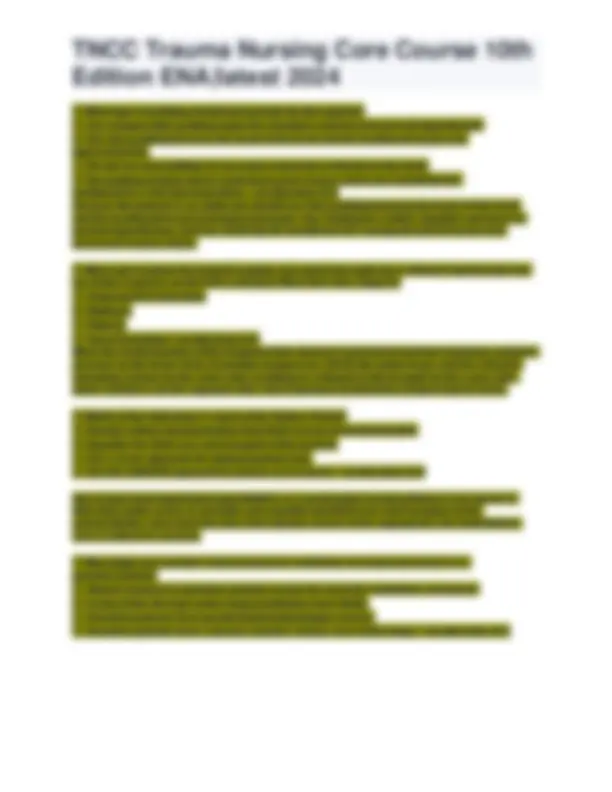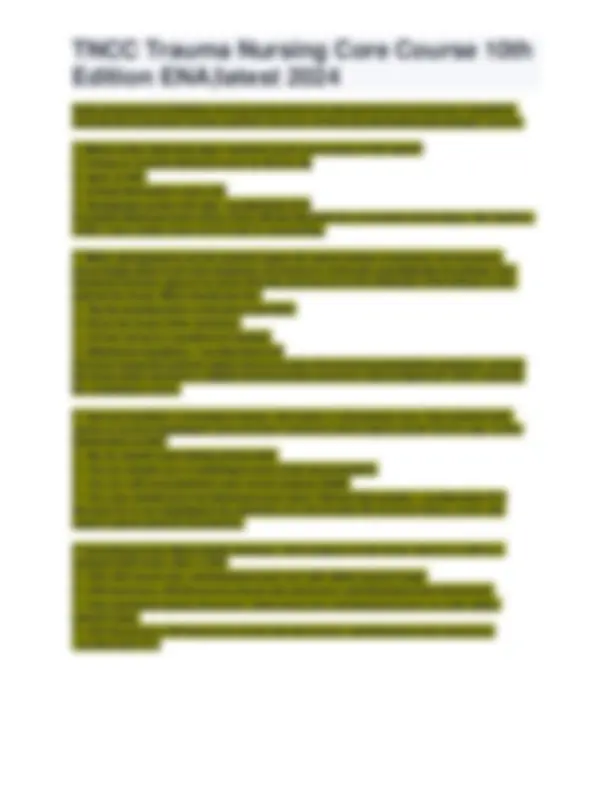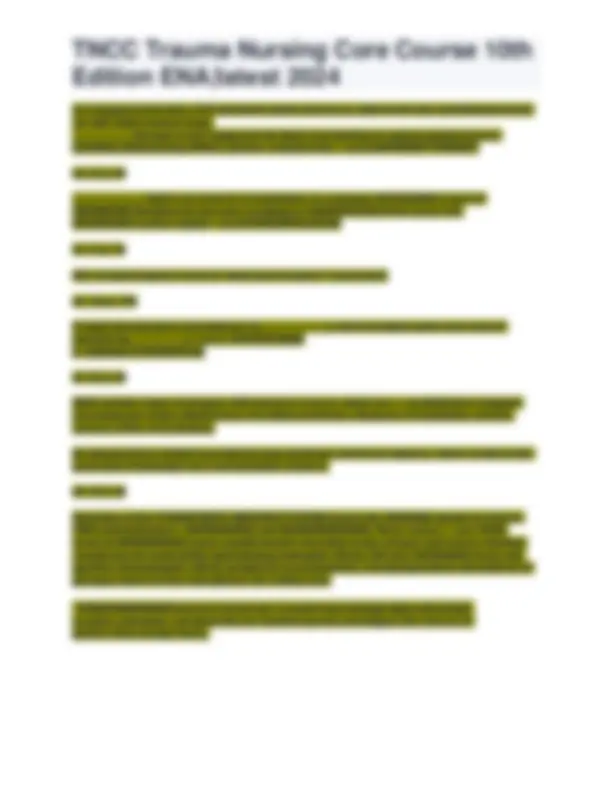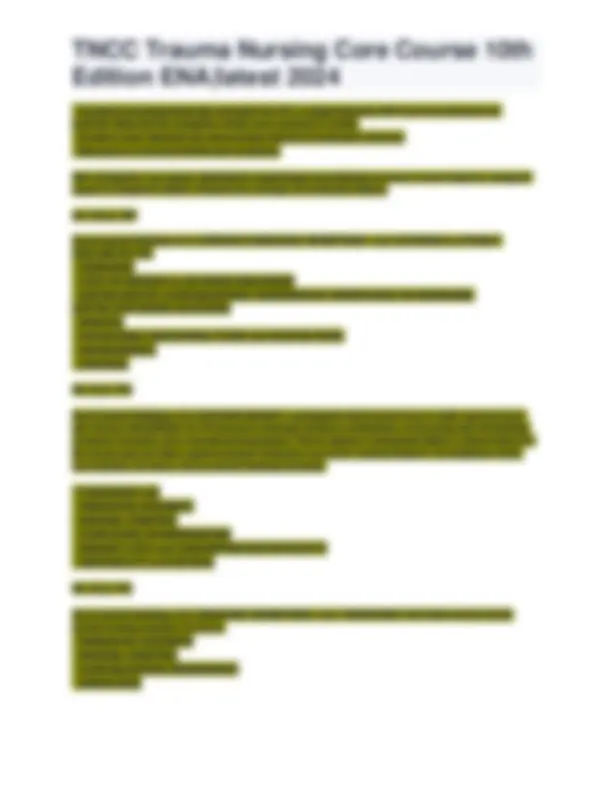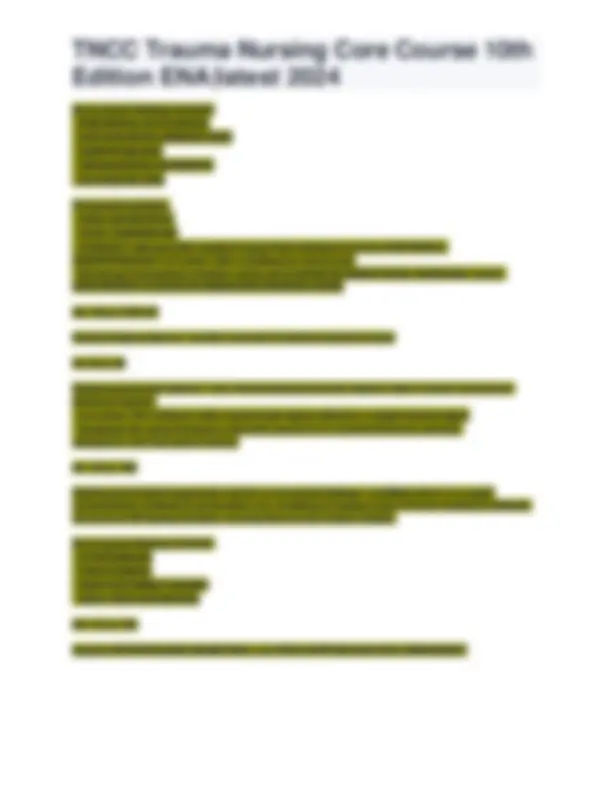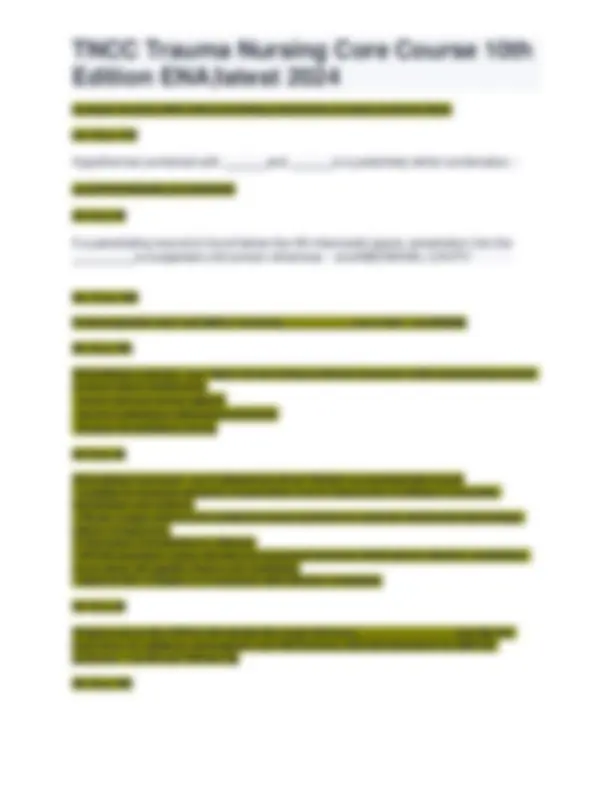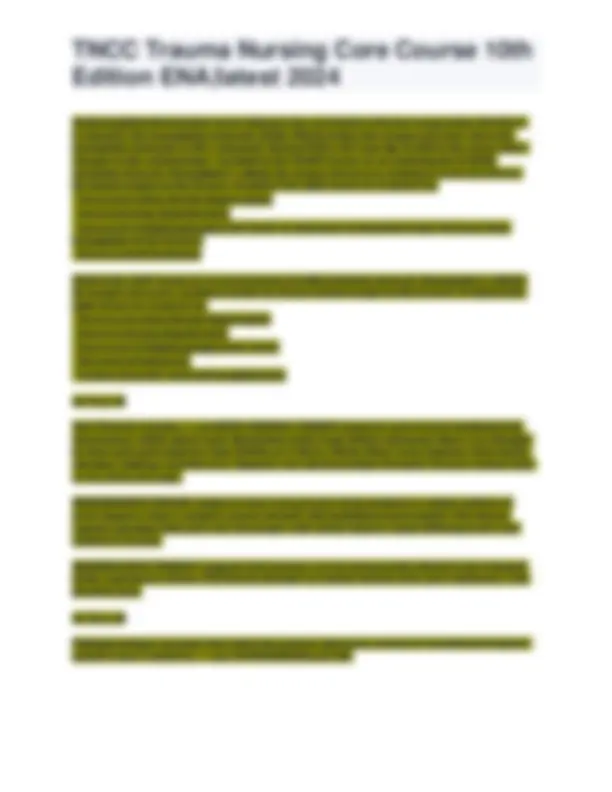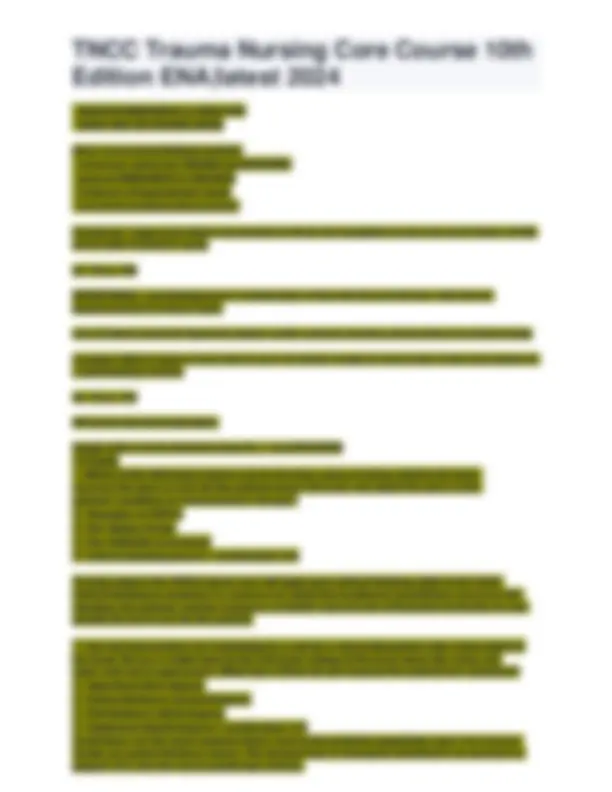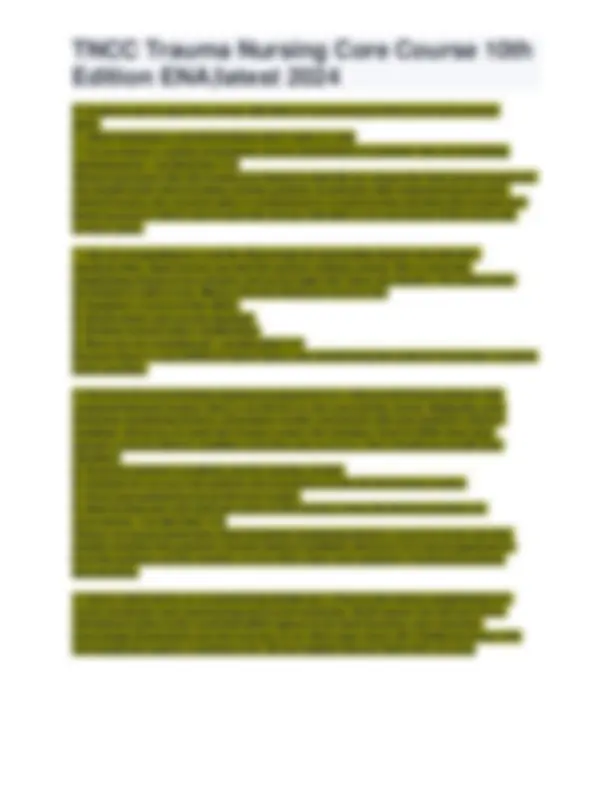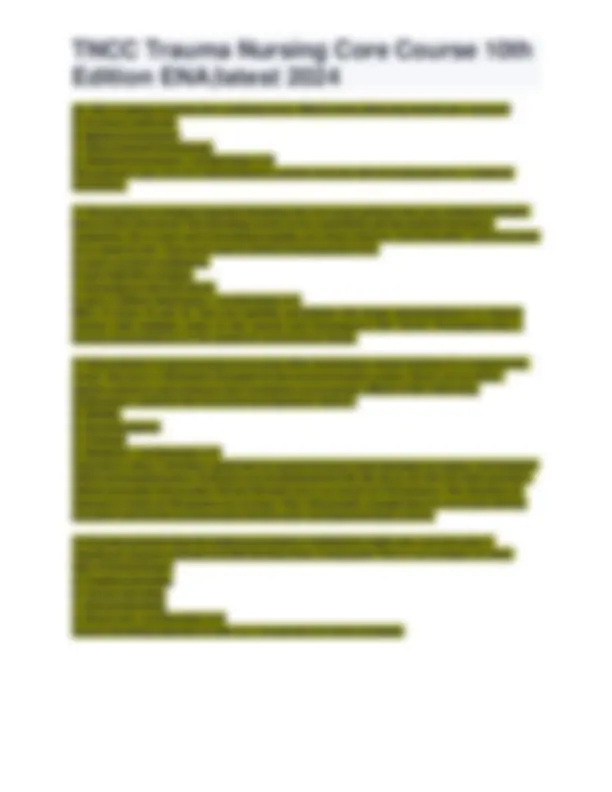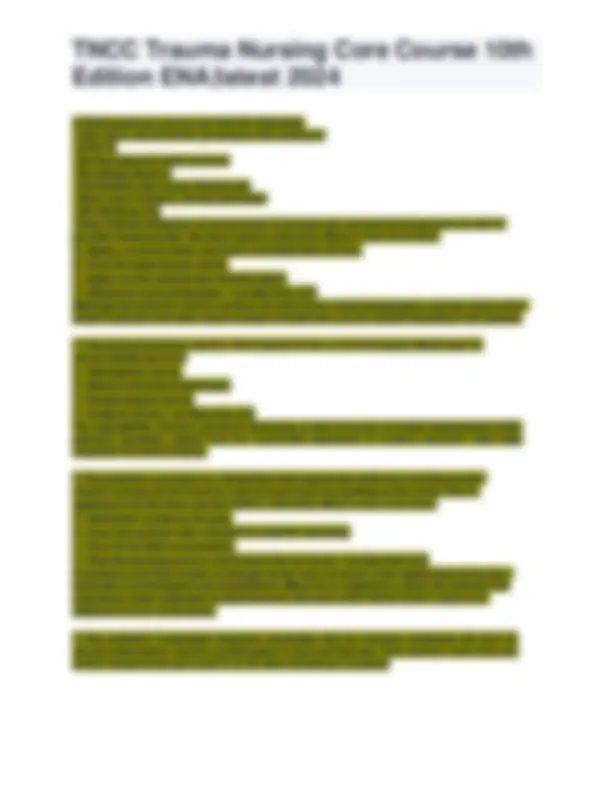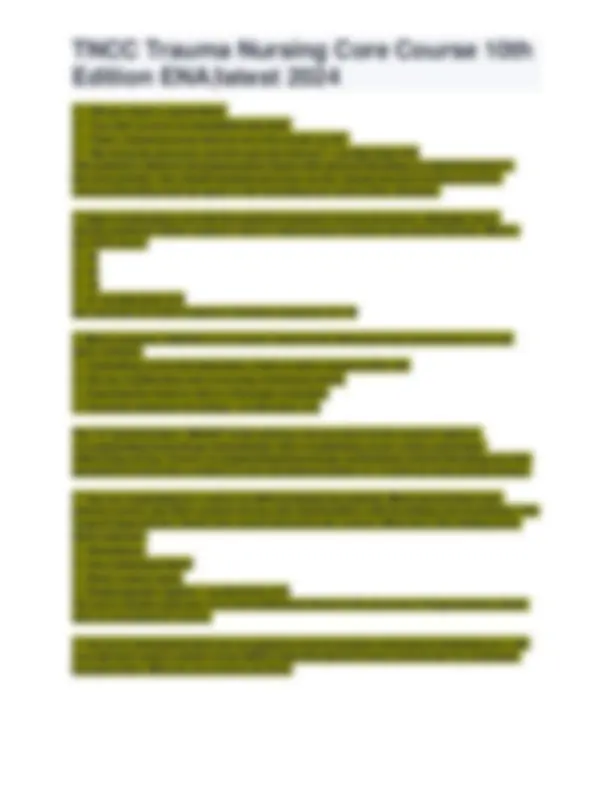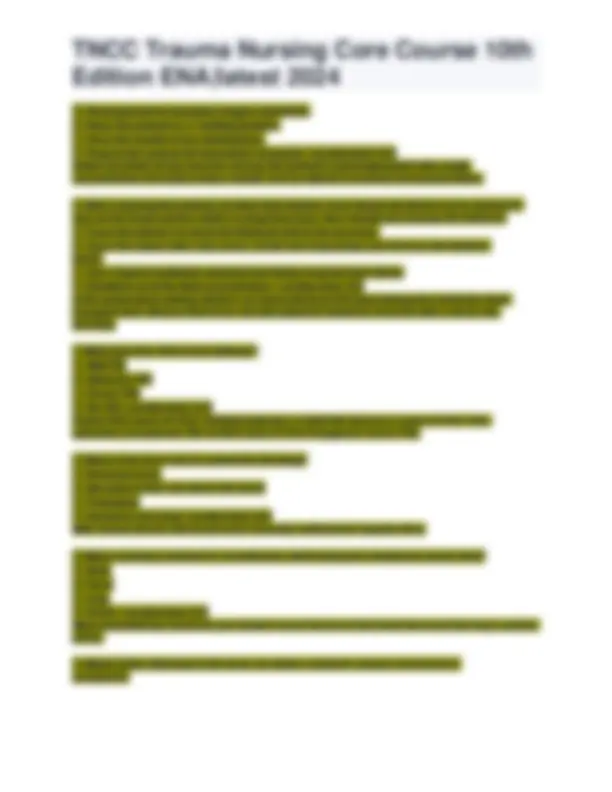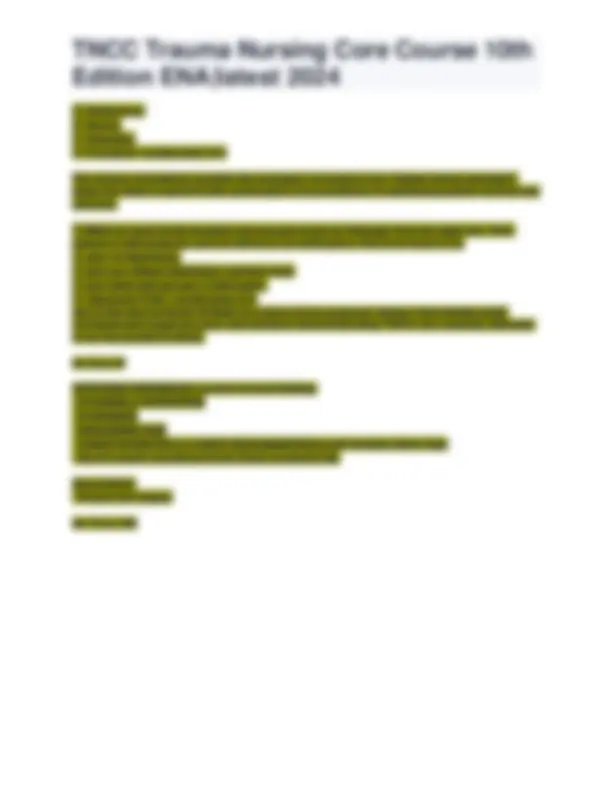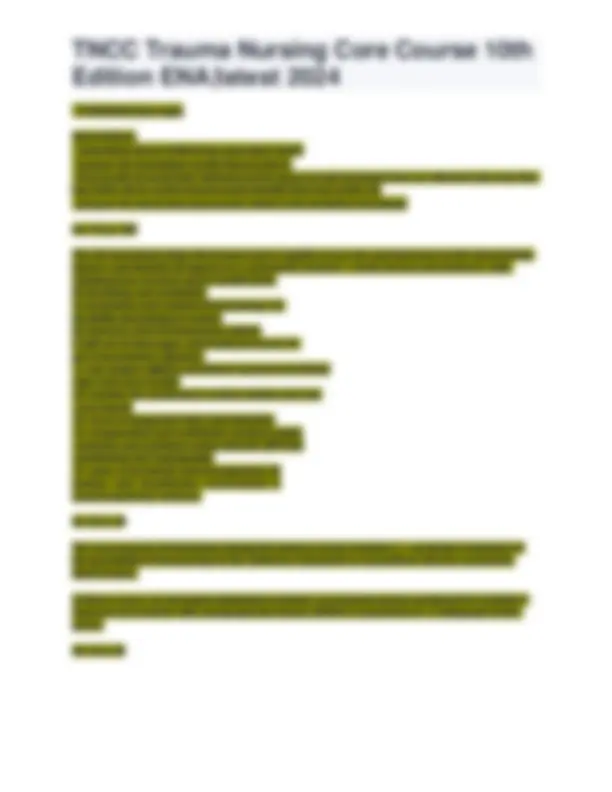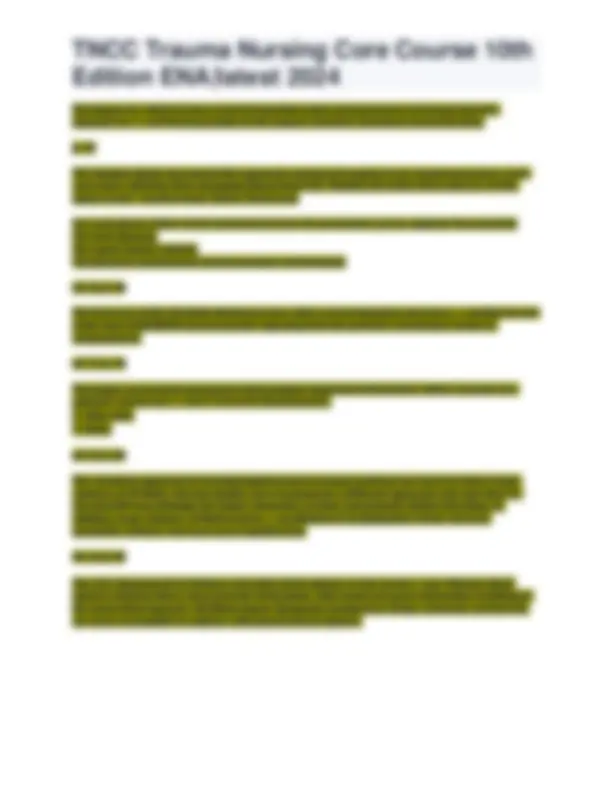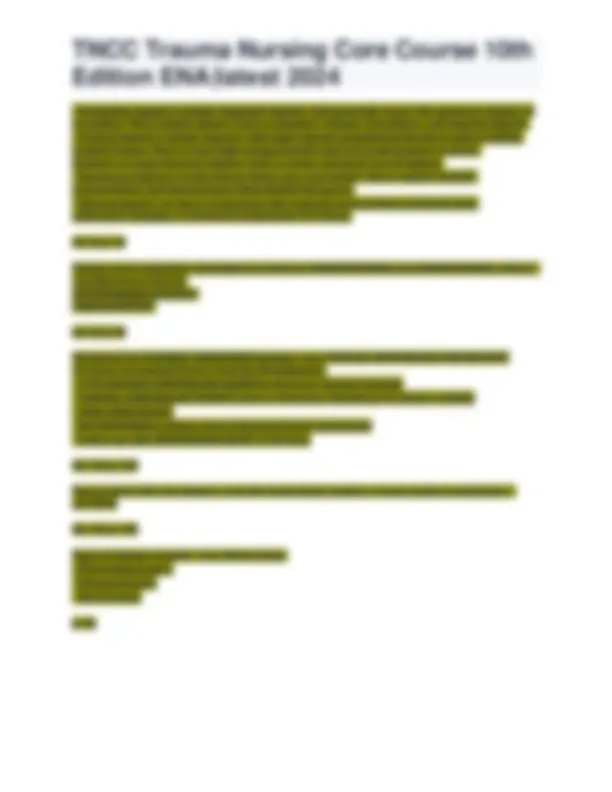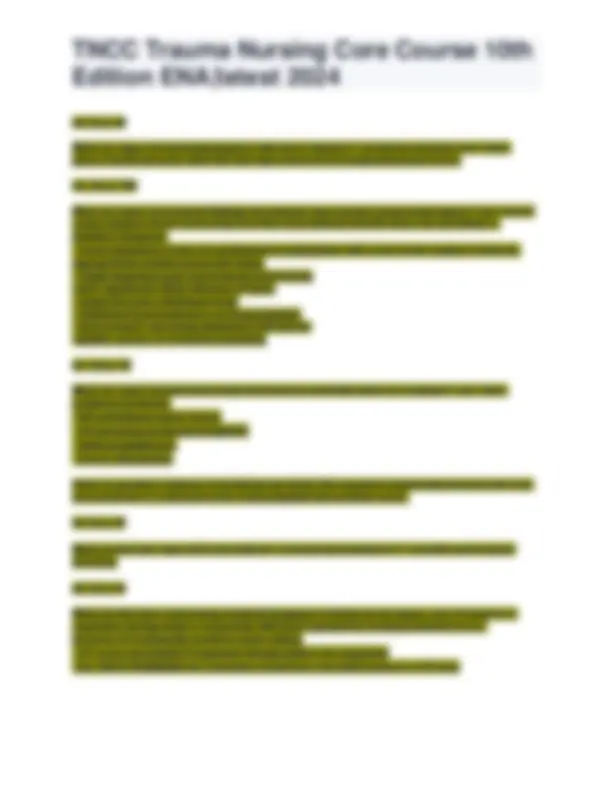Download TNCC Trauma Nursing Core Course: Practice Questions and Answers and more Exams Nursing in PDF only on Docsity!
Edition ENA|latest 2024
3. Why might it be more difficult to deal with an airway obstruction in a child?
A. Children have longer tracheas.
B. Children have larger heads and tongues so there is a greater potential for airway
obstruction.
C. Children have smaller heads, so there is less room to clear the obstruction.
D. A child's epiglottis is smaller and stiffer than an adult's. - ansQuestion 3: B Children
have larger heads and tongues as compared to an adult so there is a greater potential for airway obstruction in a pediatric patient. You must pay special attention to the proper positioning of a pediatric patient to maintain a patent airway.
3. You are oxygenating a pediatric patient using a properly fitted oxygen mask and the
"squeeze-release-release" timing technique. As you watch for the rise and fall of the chest, you check end-tidal CO2 (ETCO2) monitoring aiming to maintain what level?
A. Between 40 and 45 mm Hg
B. Between 30 and 35 mm Hg
C. Between 35 and 40 mm Hg
D. The level is irrelevant because capnography is inaccurate in pediatric patients. -
ansQuestion 3: C The proper level to maintain is between 35 and 40 mm Hg.
3. You are transporting a 37 - year-old male patient with a suspected intraabdominal
bleed. His blood pressure is 70/50 mm Hg (MAP 57), and his skin is pale and diaphoretic. How will you manage fluid resuscitation for this patient?
A. Aggressively administer IV fluids to compensate for internal blood loss.
B. Do not administer IV fluids to patients with intra-abdominal bleeding.
Edition ENA|latest 2024
C. Obtain the patient's medical records and resuscitate to his normal blood pressure
reading.
D. Carefully administer IV fluids to raise the patient's systolic blood pressure to between 80
and 90 mm Hg. - ansQuestion 3: D Abdominal trauma represents one of the key situations in which a balanced resuscitation is indicated. Aggressive administration of IV fluid may elevate the patient's blood pressure to levels that will disrupt any clot that has formed and result in recurrence of bleeding that had ceased because of blood clotting and hypotension. Prehospital care practitioners must achieve a delicate balance: maintain a blood pressure that provides perfusion to vital organs without restoring blood pressure to elevated or even normal ranges, which may reinitiate bleeding sites in the abdomen or pelvis. In the absence of TBI, the target systolic blood pressure is 80 to 90 mm Hg (mean arterial pressure of 60 to 65 mmHg).
4. After 400 mL of lactated Ringer solution, you get a radial pulse and his level of
consciousness improves. The monitor shows heart rate 110 beats/minute, blood pressure 85/60mm Hg, SpO2 95%, ventilation rate 25 breaths/minute. What should you do?
A. Give an additional 500 mL of lactated Ringer solution.
B. Stop fluids and give 2 g of TXA.
C. Give TXA and 500 mL of normal saline.
D. Give 2 mg of morphine for analgesia. - ansQuestion 4: B
The patient does not need more fluids right now. Giving morphine in a shocked patient is a risky move and could lead to dangerous hypotension.
4. The patient is wearing long sleeves, and you are having trouble visualizing the
wound. What should you do?
A. Cut the cloth away from the site until the entire wound site is visible.
B. Leave the clothing in place. Put gauze over the wound.
C. Remove the patient's shirt.
D. Cut through the slash on the sleeve, and use the material as a makeshift tourniquet. -
ansQuestion 4: A Clothing can be quickly removed by cutting. You cannot treat what you cannot see.
4. What is one reason to use capnography as part of your patient reassessment?
A. To get accurate readings for blood pressure
B. To assure proper ET tube placement
C. To measure arterial blood saturation
D. To ensure proper placement for needle decompression - ansQuestion 4: B Capnography
can monitor proper endotracheal tube placement. It doesn't read blood pressure, so it cannot beused to determine if a patient is hypotensive. Pulse oximetry, not capnography, measures arterial blood saturation. Capnography is not useful in needle decompression.
Edition ENA|latest 2024
Early mechanical ventilation via bag mask device or advanced airway measures should be considered in geriatric trauma patients because of their greatly limited physiologic reserve.
5. Which of the following signs would be most concerning at this point?
A. A drop in systolic blood pressure to 88 mm Hg
B. SpO₂ of 93%
C. A field GCS motor score of 4
D. Hemiplegia on the left side - ansQuestion 5: A
A systolic blood pressure of less than 90 mm Hg indicates secondary brain injury. Her SpO2 is
90%, and a motor score of 4 is not as concerning.
5. While attempting to lay the patient supine for spinal motion restriction she becomes
increasingly distressed and complains of shortness of breath and difficulty breathing. The fractured clavicle appears to move distally and increases the difficulty of breathing as the patient lies back. What should you do?
A. Tip the backboard to a left lateral position.
B. Raise the back of the stretcher.
C. Let her sit up in a position of comfort.
D. Administer morphine. - ansQuestion 5: B
Because laying the patient supine increases the risk of airway/ventilation problems, raising the back of the stretchers slightly fundamentally maintains spinal alignment while reducing the ventilation issues.
5. You now perform a secondary survey. You notice a sternotomy scar. Your patient tells
you he is on oral clopidogrel since he had a coronary artery bypass graft 2 years ago. Is this information useful?
A. No, he should stop talking and breathe.
B. Yes, he should see a cardiologist once in the local hospital.
C. Yes, he will need platelets and a heart surgeon ASAP.
D. Yes, you should raise his blood pressure up to 130 mm Hg systolic. - ansQuestion 5: C
Because he is on clopidogrel, his platelets are out of order for at least 5 days, so he will require urgent platelet transfusion.
6. According to the Monro-Kellie doctrine, what happens to the brain when it is still in a
compensated state after a TBI?
A. CSF, ICP, heart rate, and blood pressure are still within normal range.
B. CSF increases, ICP decreases, heart rate increases, and blood pressure decreases.
C. CSF and blood volume decrease, while heart rate and blood pressure are still within
normál range.
D. CSF decreases, ICP increases, heart rate decreases, and blood pressure increases.
Edition ENA|latest 2024
In a compensated state, CSF and blood volume decrease, while heart rate and blood pressure are still within normal range. therapy is now suggested for fluid resuscitation to replace patient losses, including administering PRBCs, plasma, and platelets. - ansCOMPONENT THERAPY ch. 5, p. 45 , which can occur in resuscitation, is a common IATROGENIC cause of INCREASED intrathoracic pressure resulting in COMPRESSION of the heart and DECREASED cardiac output. - ansHYPERVENTILATION ch. 7, p. 74 55% of spinal injuries occur to which part of spine? - anscervical ch. 13, p. 179 A rapid, thready pulse may indicate (a. ), and an irregular pulse may warn of potential (b. ). - ansa. HYPOVOLEMIA b. CARDIAC DYSFUNCTION ch. 5, p. 45 ABGs provide values of oxygen, CO2 and base excess, which are... - ansReflective endpoint measurements of the effectiveness of cellular perfusion, adequacy of ventilation, and the success of the resuscitation. An abnormal base deficit may indicate poor perfusion and tissue hypoxia, which results in the generation of hydrogen ions and metabolic acidosis. ch. 5, p. 46 Activation of the SYMPATHETIC NERVOUS SYSTEM causes the ADRENAL glands to release TWO catecholamines - EPINEPHRINE and NOREPINEPHRINE. These cause... - ans- HIGH levels of EPINEPHRINE cause smooth muscle relaxation in the airways and causes arteriole smooth muscle contractility (potentiating inotrophic effect). EPI also INCREASES heart rate (positive chronotrophic effect), peripheral vasocontriction, and glycogenolysis (breakdown of glycogen stores in liver into glucose for cellular use)
- NOREPINEPHRINE increases heart rate, vascular tone through alpha-adrenergic receptor activation, and blood flow to skeletal muscle and triggers the release of glucose from energy stores.
Edition ENA|latest 2024
As ICP rises, CPP , resulting in cerebral ischemia, hypoxemia, and lethal secondary insult. - ansDECREASES Ch. 9, p. 109 As shock progresses, primary goal of the body is to maintain perfusion to vital organs. Sympathetic stimulation has little effect on the cerebral and coronary vessels since they are capable of autoregulation. Cerebral autoregulation maintains a constant... - anscerebral vascular blood flow as long as the MAP is maintained between 50-150... when autoregulation in the brain fails, perfusion becomes dependent solely on pressure. ch. 7, p. 78 Assess pupils for... - ansEquality, shape, and reactivity (PERRL) ch. 5, p. 45 Assessment findings for MILD, MODERATE, and SEVERE TRAUMATIC BRAIN INJURY INCLUDE:
- ansMILD
- GCS 13 - 15
- Brief (<30 min) LOC
- POST-TRAUMATIC AMNESIA < 24 hours
- No change on neuron aging studies MODERATE
- GCS score 9 - 12
- Wide variety of symptoms, including ALTERATIONS IN CONSCIOUSNESS, CONFUSION, AMNESIA, and FOCAL NEUROLOGICAL DEFICITS
- May deteriorate to severe head injury over time SEVERE
- GCS score <
- Significant alterations in consciousness
- ABNORMAL PUPILLARY RESPONSE
- ABNORMAL POSTURING Ch. 9, p. 115 Assessment findings for renal injuries include - ans- Turner sign (bruising by 11th and 12th ribs)
- Hematuria
- Frank tenderness, costovertebral angle tenderness, palpable flank mass
- Structural damage or leakage of contrast on intravenous pyelogram (IVP)
Edition ENA|latest 2024
- If patient hemodyanmically unstable for CT, a single-infusion IVP can be performed at bedside followed by complete study once patient is stable
- Positive urine dipstick for microscopic blood or leukocyte esterase
- Abnormal or elevated BUN and creatinine 90% of injuries are minor. Anticipate nephrology consultation in more severe injures; surgical repair is required within 12 hours to salvage an ischemic kidney ch. 12, p. 167 Assessment findings of a CHRONIC SUBDURAL HEMATOMA - ans- ALTERED or STEADY DECLINE IN LOC
- HEADACHE
- LOSS OF MEMORY or ALTERED REASONING
- MOTOR DEFICIT: CONTRALATERAL HEMIPARESIS, HEMIPLEGIA, OR ABNORMAL MOTOR POSTURING OR ATAXIA
- APHASIA
- IPSILATERAL UNILATERAL FIXED and DILATED PUPIL
- INCONTINENCE
- SEIZURES Ch. 9, p. 114 Assessment findings of a DIFFUSE INJURY - ansInjuries that occur over a wide spread area, not always identifiable on CT because damage involves contusions or hearing and stretching of micro vascular, not a localized hematoma. These injuries commonly follow a direct blow to the head and are often sports-related. Patients can have varying degrees of symptoms that last minutes to hours. Assessment findings include:
- TRANSIENT LOC
- HEADACHE, DIZZINESS
- NAUSEA, VOMITING
- CONFUSION, DISORIENTATION
- MEMORY LOSS and CONCENTRATION DIFFICULTY
- IRRITABILITY and FATIGUE Ch. 9, p. 115 Assessment findings of a EPIDURAL HEMATOMA - ans- TRANSIENT LOC followed by lucid period lasting minutes to hours
- HEADACHE, DIZZINESS
- NAUSEA, VOMITING
- CONTRALATERAL HEMIPARESIS
- HEMIPLEGIA
Edition ENA|latest 2024
- MILD TO SEVERE MEMORY LOSS; COGNITIVE, BEHAVIORAL, and INTELLECTUAL DEFICITS Ch. 9, p. 116 AXIAL LOADING - ansetiology/cause- direct force transmitted along the length of vertebral column rest of injury- deformity of vertebral column, secondary edema of spinal cord resulting in neurologic effects example- diver striking head on bottom of pool ch. 13, p. 179 Because calcium is a vital part of the clotting casade, hypocalcemia, as a result of a massive transfusion, can actually worsen hypovolemic shock by... - ansPermitting continued bleeding Signs of hypocalemia include- dysrhythmias, muscle tremors, and seizures ch. 7, p. 81 BLUNT ESOPHAGEAL INJURY - ansInjury to esophagus, rare, results form blunt trauma Assessment findings include
- AIR in MEDIASTINUM with possible widening
- CONCURRENT LEFT PNEUMOTHORAX or HEMOTHORAX
- ESOPHAGEAL MATTER IN CHEST TUBE
- SUBCUTANEOUS EMPHYSEMA Interventions
- Prepare for surgery Ch. 11, p. 143 Brown-squared syndrome - ansContralateral loss of pain and temperature sensation and ipsilateral paralysis with reduced touch sensation ch. 13, p. 182 CARDIAC TAMPONADE - ansAssessment findings
Edition ENA|latest 2024
Beck's Triad- HYPOTENSION, MUFFLED HEART SOUNDS, DISTENDED NECK VEINS
- CHEST PAIN
- TACHYCARDIA
- DYSPNEA
- CYANOSIS
- Pulsus paradoxus greater than 10 mm Hg Interventions
- Prepare for pericardial decompression
- 3 to 4 cm incision made just left of xiphoid process
- Needle percardiocentesis may also be used to relieve symptoms of cardiac tamponade but its only temporary solution ch. 11, p. 146 Cavitation refers to the... - ansSeparation of surrounding tissue resulting from a sound and/or hydraulic wave force. This rapid motion can lead to crushing, tearing, and shearing forces on tissue. The impact of cavitation is dependent on the characterists of the affected tissue. Additional considerations include:
- Air-filled organs such as lungs or stomach, are elastic, so this tissue tolerates high- velocity cavitation relatively well compared to other tissues
- Solid organs such as the liver, have a greater propensity to shear or tear under the same forces
- If those same forces are instead released inside the cranium, bone will resist expansion, augmenting soft tissue crushing, until the tensile strength of the bone is exceeded and an explosive release of pressure results ch. 4, p. 32 Central cord syndrome - ansloss of motor function in upper extremities that is greater than that of lower extremities. often sacral sparing. bladder function may be affected ch. 13, p. 182 Classifications of acute pain are based on the source and origin and include... - ansSOMATIC pain originates from skin and muscloskeletal structures VISCERAL PAIN originates from organs and may lead to referred pain ch. 8, p. 93 Components of CUS and its purpose - ansC: I am Concerned U: I am Uncomfortable
Edition ENA|latest 2024
Define biomechanics - ansThe general study of forces and their effects p. 25 Define kinematics - ansThe study of energy transfer as it applies to identifying actual or intentional injuries p. 25 Define mechanism of injury (MOI) - ansHow external energy forces in the environment are transferred to the body p. 25 Define trauma - ans- Trauma is injury to living tissue caused by extrinsic agent
- Regardless of MOI, trauma creates stressors that exceed the tissue's or organ's ability to compensate p. 9 Depending on the motorcycle design and rider positioning, the lower extremities can collide with the handlebars, resulting in... - ansFemur and pelvis fractures and hip dislocations p. 31 Describe ANAPHYLACTIC SHOCK - ansResults from release of inflammatory mediators (e.g. histamine) which contracts bronchial smooth muscles and increases vascular permeability and vasodilation. ch. 7, p. 75 Describe DISTRIBUTIVE SHOCK - ansOccurs as result of maldistribution of an adequate circulating blood volume with loss of vascular tone or increased permeability. ch. 7, p. 75 Describe energy forms - ans- Mechanical (energy transfer from one object to another in the form of motion)
- Thermal (energy transfer of heat in environment to the host)
- Chemical (heat energy transfer from active chemical substances such as chlorine, drain cleaner, acids, or plants)
- Electrical (energy transfer from light socket, power lines, or lightning)
Edition ENA|latest 2024
- Radiant (energy transfer from blast sound waves, radioactivity such as a nuclear facility, or rays of the sun) p. 26 Describe FOCAL BRAIN INJURIES - ansOccur in localized area with grossly observable and identifiable brain lesions. They include...
- CEREBRAL CONTUSION
- INTRACEREBRAL HEMATOMA
- EPIDURAL HEMATOMA
- SUBDURAL HEMATOMA
- HERNIATION SYNDROMES Ch. 9, p. 113 Describe NEUROGENIC SHOCK - ansOccurs with SCI results in the loss of SNS control of vascular tone, which produces venous and arterial vasodilation. ch. 7, p. 75 Describe SEPTIC SHOCK - ansCaused by systemic release of bacterial endotoxins, resulting in an increased vascular permeability and vasodilation. ch. 7, p. 75 Describe the MOI associated with brain, cranial, and maxillofacial trauma - ansBLUNT injury - falls, MVCs, sports-related injuries, recreation PENETRATING injury - firearms or exploding objects or projectiles Ch. 9, p. 108 Describe the three E's of injury control - ansEngineering: technological interventions such as side impact airbags, automated blind spot alarms, ignition lock devices for those with DUIs. In playgrounds and sports, this involves surface material under playground equipment and athletic safety gear. Another intervention is improved use of smoke alarms in fire prevention Enforcement and legislation: include laws at all jurisdictional levels regarding driving while intoxicated, booster seats, primary seatbelt use, and distracted driving. For sports this includes rules regarding illegal hits, examination after impact, and return-to-play requirements after a head injury
Edition ENA|latest 2024
Early treatment for septic shock includes... - ansEarly administration of antibiotics and potential need for norepinephrine to vasoconstrict the peripheral vasculature, increase blood volume return to heart, and improve cardiac output. ch. 7, p. 75 Examples of referred pain include... - ans- radiating to left shoulder (Kehr sign)
- referred to testicle may be indicative of duodenal injury
- always begin palpation away from inital site of pain by assessing the painful area last ch. 12, p. 158 Explain 3 phases of injury prevention - ansPrimary: prevention of the occurrence of the injury Secondary: Reduction in the severity of the injury that has occurred Tertiary: Improvement of outcomes related to the traumatic injury p. 10 Explain definitive care on pancreatic trauma - ans- Non-op management including complete bowel rest, nutritional support, serial CT scanning with observation
- Pseudocyst formations may be managed with percutaneous drainage
- Pancreatic ductal injuries may need distal pancreatectomy
- complications from pancreatic injury include, secondary hemorrhage, pancreatic fistula, abdominal abscess
- s/s of infection occur often 7 - 10 days after injury and usually include fever, elevated WBC, nausea, vomiting ch. 12, p. 164 Explain emergency thoracotomy - ansDone when patient arrives with unstable vital signs or impending arrest... Indications for performing this include:
- PERICARDIAL TAMPONADE needed to be evacuated
- IMMEDIATE CONTROL OF MASSIVE INTRATHROATIC BLEEDING
- PENETRATING TRAUMA with witnessed CARDIAC ARREST permitting open cardiac massage, or with massive hemorrhage in peritoneal cavity needing cross-clamping of aorta
- It is rarely successful in patients with blunt chest trauma Ch. 11, p. 142 - 143 Explain eye irrigation when used for the removal of chemicals, foreign bodies, and debris from eye - ansCONTRAINDICATED in patients who may have RUPTURED GLOBE
Edition ENA|latest 2024
- Prior to procedure, check eye pH then instill anesthetic drops unless contraindicated.
- Use warmed NS or LR, warmed to body temp 37 C to limit risk of thermal injury
- Morgan lens or intravenous tubing may be used to direct flow, remember the shorter the tubing, the greater the flow and pressure
- Direct stream across eye from inner to outer eye
- Irrigation continued until eye pH reaches neutral (7.0-7.3) Ch. 10, p. 133 Explain GLOBE RUPTURE - ans- Considered a genuine EMERGENCY
- Occurs when full thickness injury occurs to cornea or sclera or both
- Once Dx is confirmed, it is important to protect eye from further injury Assessment findings include:
- ANTERIOR CHAMBER APPEARING FLAT/SHALLOW
- IRREGULAR or TEARDROP-SHAPED PUPILS or PRESENCE of what looks like a secondary pupil due to a tear in the ciliary body (traumatic iridodialysis)
- PERIORBIAL ECCHYMOSIS
- DECREASED VISUAL ACUITY and EOM
- SEVERE SUBCONJUNCTIVAL HEMORRHAGE
- NAUSEA
- PAIN Treatment includes:
- AVOID ANY TYPE OF PRESSURE TO GLOBE - DO NOT PERFORM TONOMETRY
- APPLICATION OF RIGID SHIELD to protect affected eye
- Administration of antiemetics
- AVOID USE OF OPHTHALMIC DROPS or MEDICATIONS
- CONSULTS
- Pain not always present in globe penetration Ch. 10, p. 131 Ch. Ch. 10, p. 131 - 132 Explain how to assess circulation and control of hemorrhage in relation to thoracic trauma - ansAuscultation for:
- MUFFLED HEART SOUNDS or MURMURS Palate for:
- CENTRAL PULSES compare quality between left and right and lower and upper
Edition ENA|latest 2024
Assessment findings include:
- PERIORBIAL ECCHYMOSIS
- DIPLOPIA WITH UPWARD GAZE
- ENOPHTHALMOS
- INFRAORBITAL NUMBNESS
- DECREASED EOM Treatment includes:
- ORAL ANTIBIOTICS
- COOL COMPRESSES
- CONSULT with possible surgical repair if pt continues to have DIPLOPIA or ENOPHTHALMOS 1-2 weeks after swelling has decreased
- Discharge instructions include: advise pt to AVOID BLOWING NOSE, SNEEZING, and/or PERFORMING A VASALVA MANEUVER BEARING DOWN Ch. 10, p. 130 - 131 Explain oligoanalgesia - ansthe concept of undertreatment of pain ch. 8, p. 94 Explain pancreatic injuries - ans- Penetrating pancreatic injuries often sustain concurrent duodenal injuries
- Less than 10% of those with a pancreatic injury will have a single-system injury
- Suspicion for spinal fractures when the pancreas is crushed between anterior abdominal wall and spinal column ch. 12, p. 164 Explain pericardial tamponade and its assessment findings - ansWhen there is a rapid accumulation of blood in pericardial sac, resulting in compression of heart making it difficult for heart to fill during diastole, causing decreased cardiac output. Assessment findings include:
- HYPOTENSION
- TACHYCARDIA
- MUFFLED HEART SOUNDS
- NECK VEIN DISTENTION Ch. 11, p. 141 Explain RETROBULBAR HEMATOMA - ansTRUE OPHTHALMOLOGIC EMERGENCY
Edition ENA|latest 2024
Hemorrhage into space behind globe; bleeding causes increased pressure behind globe causing elevation in IOP that compresses optic nerve and blood vessels. Early recognition is imperative to save vision. Assessment findings include:
- SEVERE PAIN
- DECREASED VISION
- REDUCED EYE MOVEMENT
- IOP > 40 mm Hg Treatment include:
- Emergency decompression via LATERAL CANTHOTOMY indicated with IOP > 40 mm Hg Ch. 10, p. 131 Explain stable and unstable pelvic fractures - ansStable- does not involve pelvic ring or there is minial displacement of pelvic ring Unstable fractures- 2 or more fractures of pelvic ring that have outward rotational displacement ch. 12, p. 166 Explain the AVPU mnemonic - ansUsed to quickly assess patient's level of alertness A- ALERT (If any of the responses below are elicited at this point, the airway may be compromised) V- responds to VERBAL stimuli, airway adjunct may be needed to keep tongue from obstructing airway P - responds to PAIN. U- UNRESPONSIVE. If patient is unresponsive, announce loudly to the team and direct someone to check if the patient has a pulse while assessing if the cause of the problem is the airway. Consider reprioritizing the assessment priority to ABC ch. 5, p. 42 Explain the B2-Transferrin test - ansGold standard for identifying CSF otorrhea or rhinorrhea ch. 5, p. 48

